The Daylesford Screens
Peter Meehan
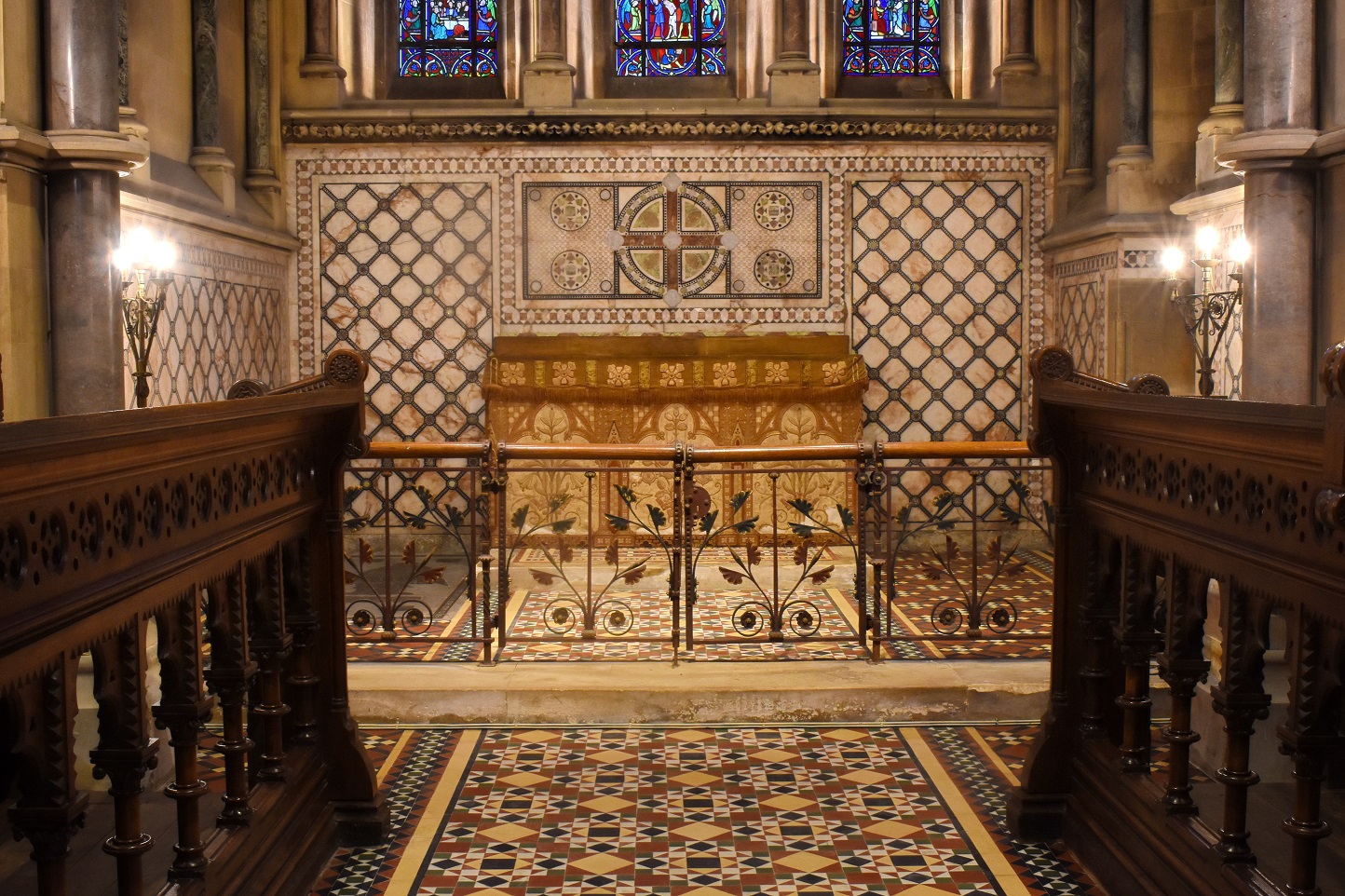
The chancel crossing with the conserved transept screens on either side, rewired light fittings and the altar rail (Photo: Jonathan Taylor)
St Peter's Church in the Cotswold village of Daylesford contains two very ornate, painted iron transept screens. These, and other Victorian metalwork in the church are believed to be the work of Francis Skidmore, a well-known craftsman and leading figure in the Gothic Revival Movement, who is perhaps best known for the Hereford Screen now on display in the Victoria and Albert Museum, London.
The church itself is a Grade I listed building which was designed in 1859 by John Loughborough (JL) Pearson (1817–97), a Gothic Revival architect, but it is now redundant and in the care of St Peter’s Daylesford Charitable Trust. The church building required some conservation and repair to its fabric, and conservation architects Donald Insall Associates were employed by the charitable trust to undertake this.
Works included repairs to deteriorating stonework inside the church, repairs to the stone-tiled roof, renewal of the electrical wiring, an enhanced lighting scheme, and the cleaning and consolidation of the ironwork transept screens, altar rail and wall lights.
Historic Background
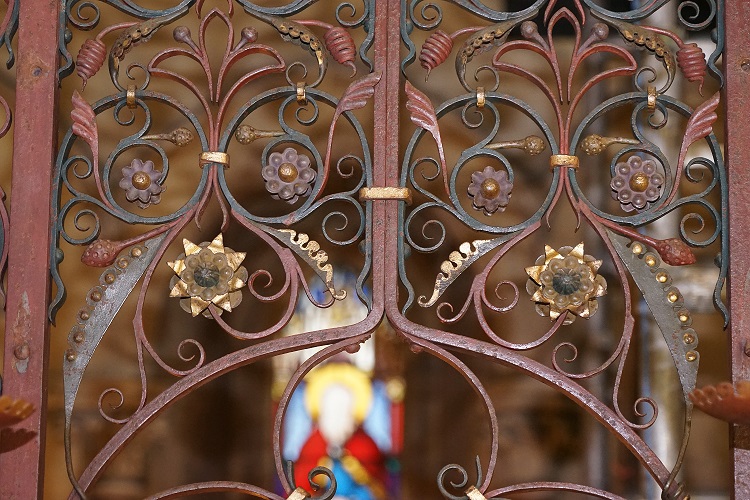 |
|
| A small section of one of the iron transept screens at St Peter’s Church in Daylesford, Gloucestershire showing its decoration after conservation (Photo: Peter Meehan). |
St Peter’s Church was built in 1863 for Harman Grisewood, the new owner of the adjacent manor house, to replace the Norman church that dated from the 12th century. His chosen architect, JL Pearson, had a long association with church architecture, and was responsible for designing a large number of church buildings, including Truro Cathedral (1880).
The new church at Daylesford was built in high Gothic style on a cruciform plan with a pyramidal spire of limestone, with red sandstone features and stone slate roofs. The interior was decorated with mosaic marble walls, fine floor tiles and painted wrought iron transept screens, altar rails and wall lights.
Although no direct evidence has been found to confirm that the decorative ironwork in St Peter’s church was by Francis Skidmore, the style, date of manufacture and Skidmore’s link to Pearson point to them being made at his Coventry factory. JL Pearson worked on a number of churches with internal decorative ironwork where the wrought iron is known to have been supplied by Skidmore.
These include St Mary’s, in South Dalton, Yorkshire which was being built at almost the same time, but here a ledger entry survives that confirms that the ironwork was supplied by Skidmore. Furthermore, during the initial examination of the transept screens at Daylesford, a number of stamp marks were found on the main iron uprights which appear to be the letters ‘SC’ and a crown.
Similar ‘SC’ stamps have also been found on verified Skidmore pieces and record the iron’s high quality. The initials stand for Skidmore’s Art and Manufactures Company. By this time (the early 1860s) Francis Skidmore was already a rising star in the Gothic Revival Movement.
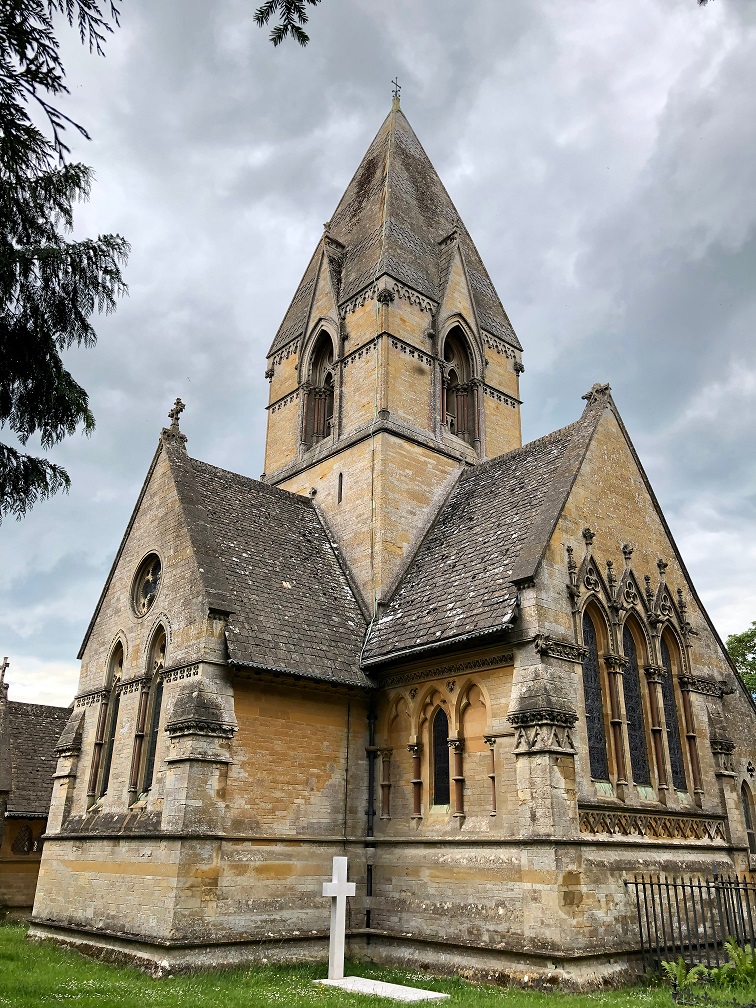 |
|
| The Gothic Revival exterior of St Peter's church (Photo: Peter Meehan) |
Originally trained in his father’s jewellery business in Coventry, he and his father had moved into the manufacture of ecclesiastical and domestic ironwork in the early 1850s. In 1855 Francis had been invited to design the roof for the new natural history museum in Oxford, and by 1859 he had begun work on the first of three cathedral screens designed by Gilbert George Scott (1811–78), another leading light of the Gothic Revival.
Their choir screen for Hereford Cathedral was displayed at the International Exhibition of 1862 where it drew widespread praise from visitors and the award of a special medal in metalworking for its design and workmanship.
The Conservation Programme
Apart from its association with Francis Skidmore, the St Peter’s ironwork was important due to its high quality and for its excellent condition. When the paint finish to the screens had been examined by Helen Hughes of Historic Interiors Research and Conservation, she confirmed that much of the ironwork retained its original colour scheme and that only the altar rails had been painted for a second time.
Despite the fact that the church had been redundant for a number of years there was surprisingly little loss of these paint coatings. Because of the unusual survival of the original colour scheme, the architect, Donald Insall Associates, advised that it should be examined by a specialist metals conservator and a detailed condition report be prepared. Peter Meehan ACR, of the Historic Metalwork Conservation Company, was approached to carry out the survey of the transept screens in June 2019.
Not only the two transept screens, but also the altar rail and wall lights, had all been made from forged wrought iron elements and finished using linseed oil-based paints, consisting of a red iron oxide primer, a light blue undercoat and a coloured finish.
Each screen is divided into five sections/bays by decorative iron uprights. A repeating screen sits at low level divided up into small squares by crisscross bars. Set at the centre of each square is a decorative flower detail. The detailing at high level is very ornate, with a series of high-level panels between each upright, all ten being of a different design.
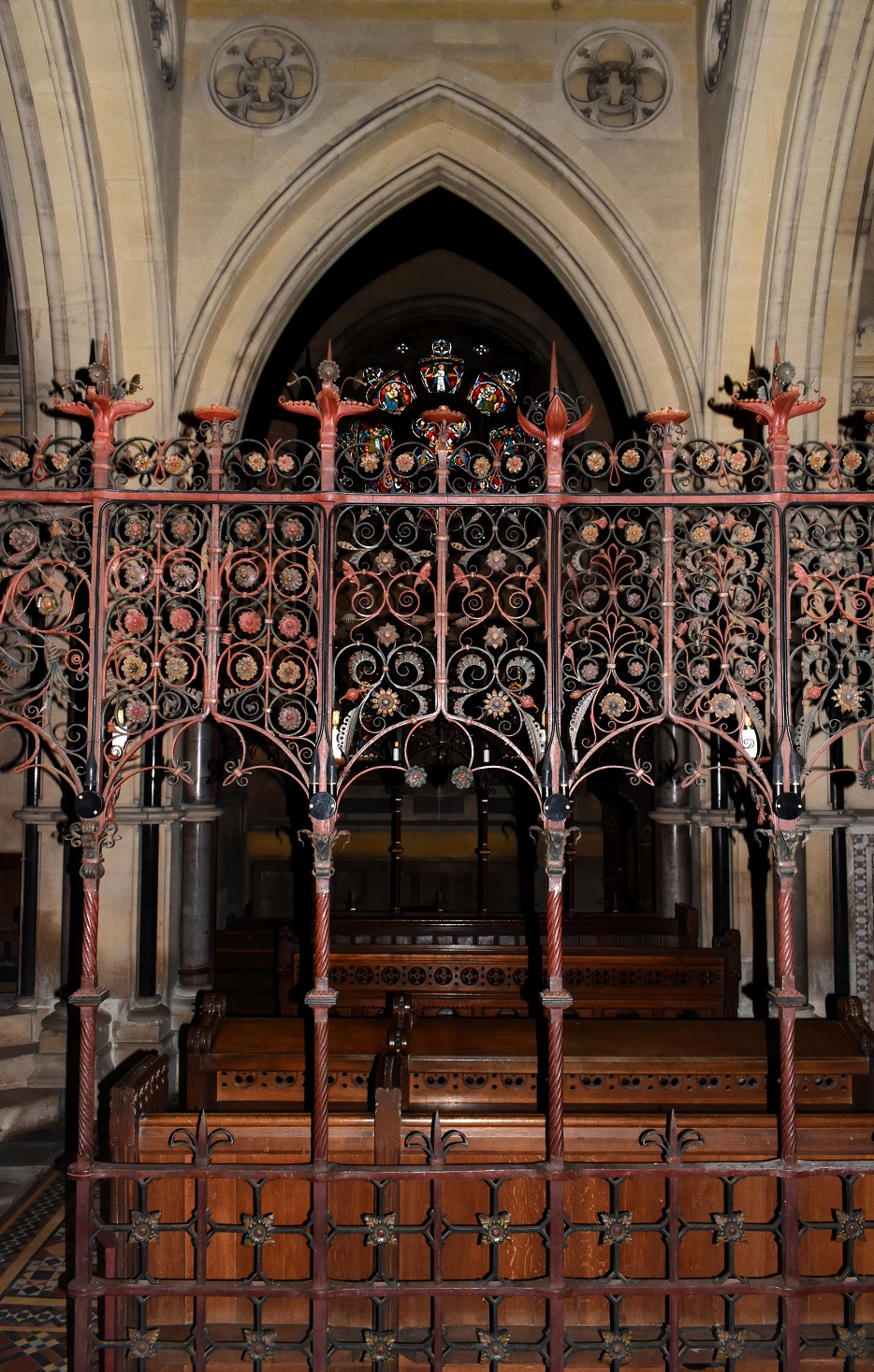 |
|
| The south transept screen after cleaning and consolidation (Photo: Jonathan Taylor) |
Decorative elements are finished in dark reds, dark green, blue, yellow and purple, with gilding used to highlight certain features to the nave side of each screen. Although the ironwork was located inside the church building and so was protected from the elements, there was little or no heating or environmental control inside.
As a result, the ironwork had been affected by condensation during the colder months. The original paint finishes had been applied to provide protection to the ironwork as well as to give it a decorative finish, but this was now very old and had degraded.
Moisture had penetrated to the iron beneath through flaws in the paint layers, leading to small areas of corrosion and rust formation. In addition, as the church is no longer in regular use, there has been no recent cleaning to the iron transept screens, resulting in a build-up of dust and dirt layers.
Cleaning Trials
After the condition survey of the transept screens and altar rail, proposals were put together for the conservation of this very important ironwork. The main recommendation was to carry out some initial cleaning and conservation trials to find the best cleaning technique, and in addition a trial of suitable materials to use for consolidating the deteriorated paint layers and treating the localised rust patches.
A small section to one of the lower screens was selected for the trials. This was initially dry-cleaned with conservation brushes and a vacuum cleaner. The painted surfaces were then wet cleaned with a non-ionic detergent (1% TritonX100) and distilled water (which is pH neutral), applied using cotton wool swabs rolled across the surface.
Small rust blisters and areas of loose rust were carefully removed under magnification using a scalpel blade, and brushed with a fine glass bristle brush back to a sound surface. Four potential substances were selected to test which would be the most suitable for consolidating the paint layers and enhancing the overall colour of the paint finishes, which had dulled with age.
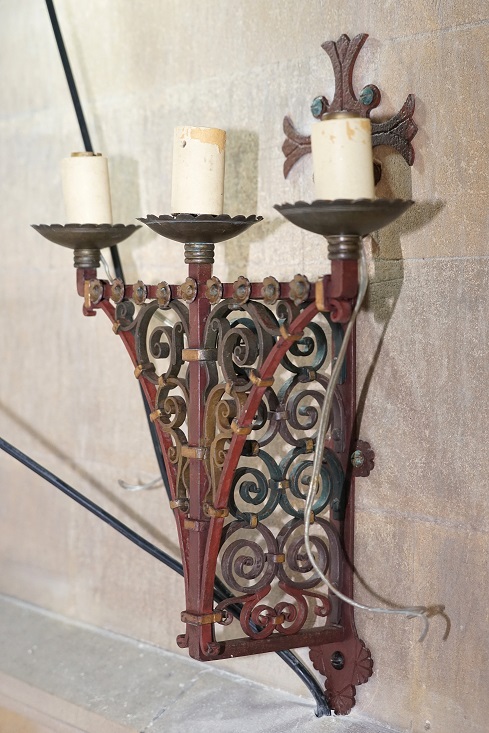 |
|
| The original colour scheme is revealed on one of the wall lights. (Photo: Peter Meehan) |
These were: a five per cent solution of Paraloid B72; a five per cent solution of Paraloid B67 (both acrylic resins in white spirit); Primal WS24; and Lascaux 4176 (both acrylic dispersions in water). Four identical decorative flowers on the lower panel were selected for testing, so the resulting finish could be compared.
Two coats of each consolidant were applied, allowing the first to dry before applying the second. A visual assessment suggested that the Paraloid B67 solution in white spirit gave the best result. Following the success of the cleaning and consolidation trials the original paint finish had been significantly enhanced.
The client therefore decided to go ahead with the conservation of the transept screens, altar rail and wall lights. The works began in September 2020 during the first lifting of Covid-19 restrictions.
Cleaning and Consolidation
The transept screens were photographed before being dry cleaned with soft brushes and a vacuum cleaner. Attempts were made to wet clean the paint layers and iron, but over larger areas this appeared to be less successful than during the trials. There was also some concern about introducing water to areas of unpainted iron where paint layers had been lost.
These generally consisted of tiny rust blisters that had lost their tops. An alternative dry-cleaning technique was tried using Scotchbrite, fine abrasive pads made by 3M that come in a range of grades, the finest being equivalent to fine-grade wire wool.
A cleaning routine was developed where three grades of pad were used, firstly very fine, then ultra-fine, and finally finishing with a light cleansing pad. This combination was found to successfully remove the remaining dirt layers and to revive the original paint surface.
Small patches of rust were carefully removed using fine brass bristle brushes. Each screen had a number of candle sconces fitted: a row at high level and a row above the choir stalls. These had large accumulations of candle wax remaining in them, which were carefully removed using wooden picks.
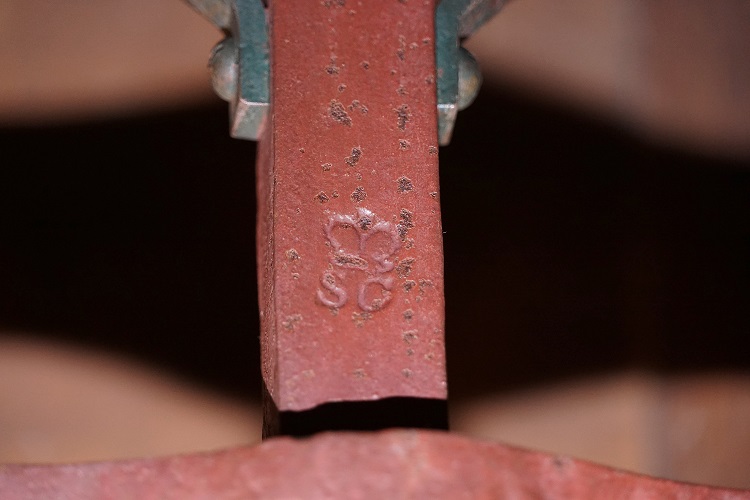 |
|
| Forge-marks on the screens may indicate that they were by Francis Skidmore. (Photo: Peter Meehan) |
The same dry-cleaning routine with Scotchbrite pads was applied to the painted altar rails and wall lights. The latter were labelled and removed to a workshop while the electricians completed the fitting of new electric cables. As the decorative detail was much finer on these pieces, the cleaning process was far easier to carry out on a workbench.
Once the cleaning works were complete, each screen was cleaned with soft brushes and a hand puffer to remove any remaining dust deposits, while a vacuum cleaner collected the residues. The painted surfaces were then consolidated with two coats of five per cent Paraloid B67 in white spirit applied by brush and left to dry for 24 hours between coats.
This helped to fully revive the paint colours, as well as consolidate the surfaces. The screens were then finished with an application of a layer of Renaissance microcrystalline wax, which was buffed up with soft brushes once it had dried. The result is that the original ironwork and its decoration has been protected from further deterioration, and its appearance enhanced so that the original colour scheme can be better appreciated.



